The supertonic is the second degree in any scale, playing a key role in connecting the tonic to other chords and creating harmonic movement.
Whether you’re building a progression, laying down a melody, or layering harmonies, it can help you add depth and tension to your tracks.
Plus, it opens up new ways to experiment with minor scales and major keys.
As producers, understanding the supertonic can seriously help you create more professional-sounding progressions and give your harmonies a unique edge.
As well as create smoother transitions in your music.
That’s exactly why we’re breaking down everything you need to know, like:
- What the supertonic is ✓
- How scale degrees work ✓
- The function of the supertonic in progressions ✓
- Using the supertonic as a predominant chord ✓
- Differences between the supertonic in major and minor keys ✓
- Supertonic’s role in melodies and harmonies ✓
- Expert tips for using the supertonic ✓
- How to incorporate supertonic chords in your own tracks ✓
- Much more ✓
After reading this guide, you’ll know everything about the supertonic and how to use it to enhance your tracks and theory knowledge.
This way, you can create chord progressions with more tension and resolution, layer harmonies that stand out, and use it to connect different sections of your track.
Plus, you’ll be able to experiment with first inversion, diminished chords, and more advanced harmonic techniques to take your music to the next level.
So, let’s dive in…
Table of Contents
What is the Supertonic?
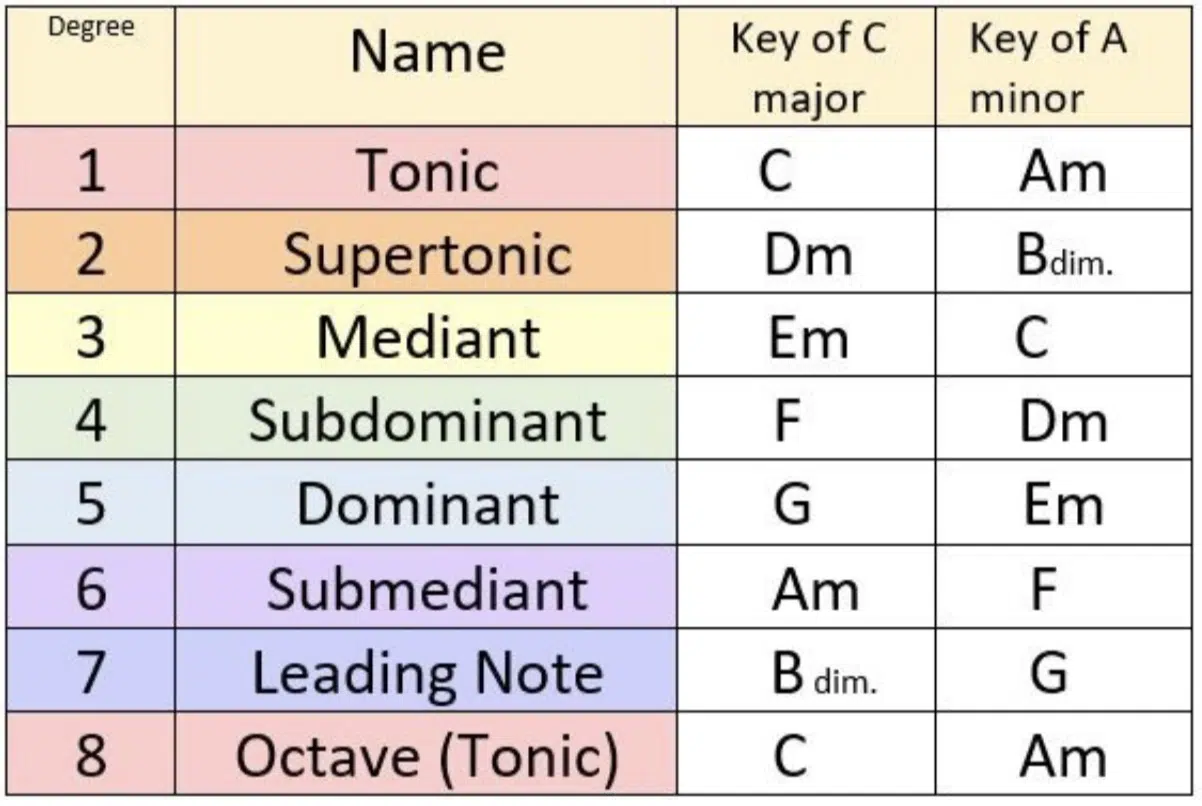
The supertonic is the second degree in a scale, positioned right after the tonic 一 it’s a key part of understanding music theory, especially in major and minor scales.
The supertonic sets up a unique tension in music, leading smoothly into more dominant chords like the V chord or resolving into the subdominant.
In both the major and minor scale, this note adds freshness and movement to progressions, especially when building harmonies.
It plays a key role in a wide variety of chord progressions, creating tension before resolving back to the tonic or leading tone.
Don’t worry, we’ll break it all down throughout today’s article so you can really get a better understanding of it.
Understanding Scale Degrees
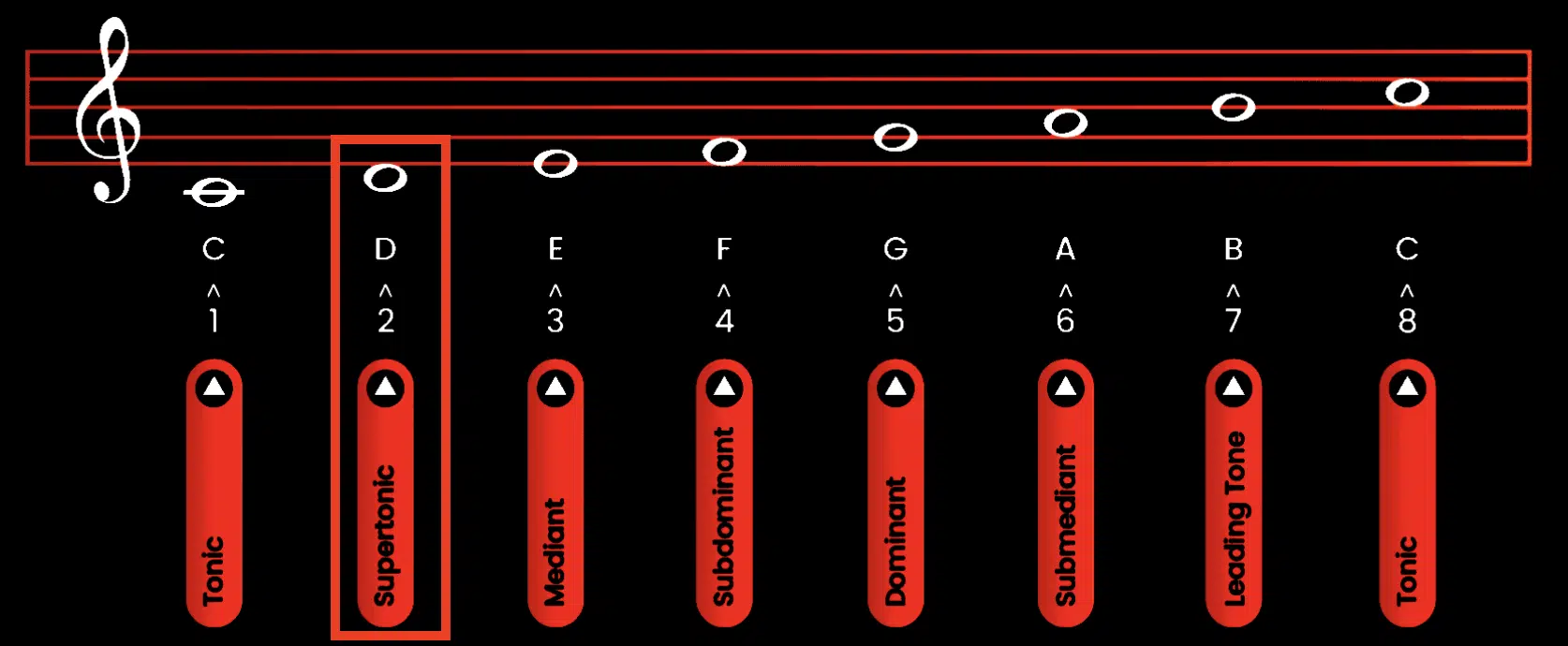
To fully understand the supertonic, you need to know what scale degrees are.
In any major or minor scale, each note has a number called a degree, with the tonic as the first degree and the supertonic as the second.
Each degree has its own function in a:
- Melody
- Harmony
- Chord progression
The supertonic often transitions into the dominant or subdominant 一 creating that flow between chords and adding variety to your music.
For example, in the key of C major, the supertonic (D) often leads into the dominant (G) or subdominant (F) to create tension and release.
Using it this way allows you to connect different sections of a song, such as transitioning from a verse to a chorus.
It provides a smooth harmonic flow that keeps the listener hooked.
The Function of the Supertonic in Chord Progressions
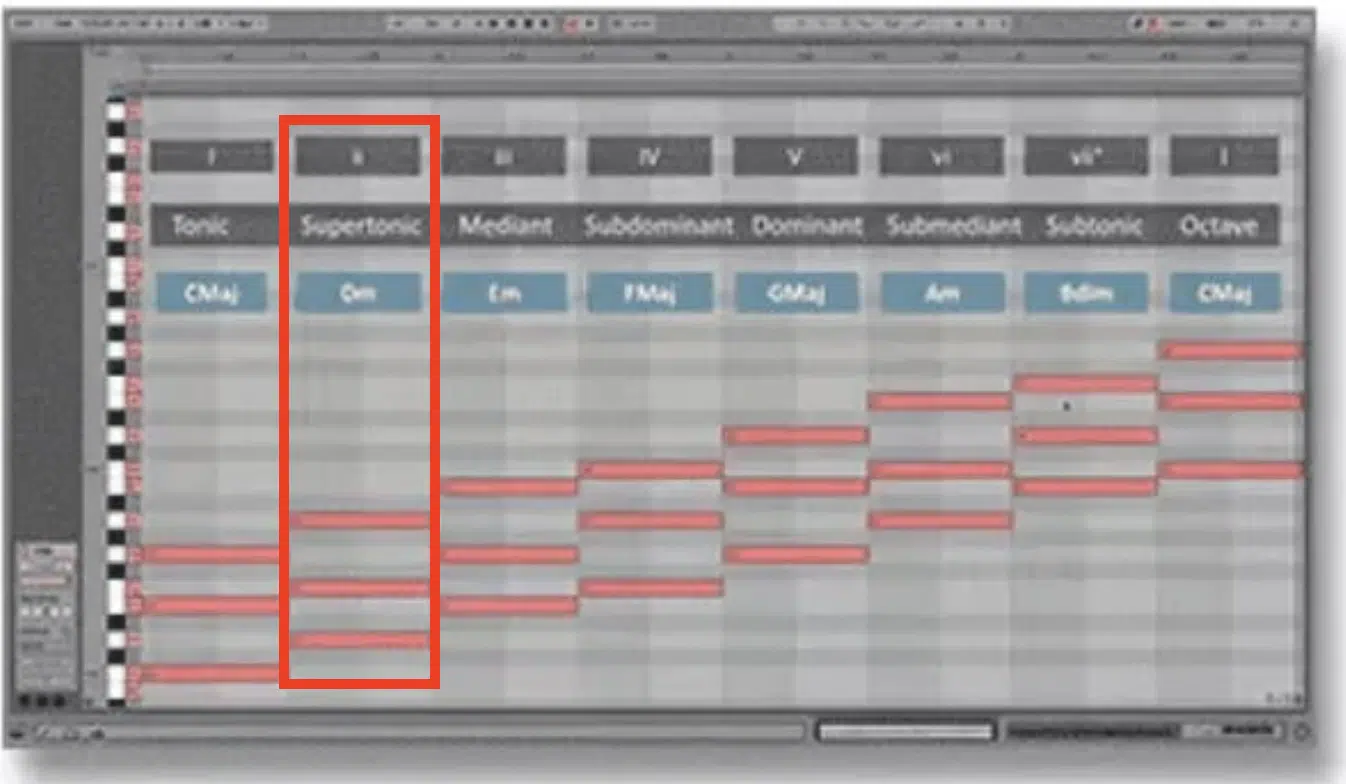
C major
In a major key, the supertonic chord is often a minor triad, known as the ii chord.
This minor chord naturally builds tension, which makes it perfect for transitioning into the dominant V chord.
In a minor scale, it can also be part of a diminished chord to drive home the dramatic feel of your progression.
The supertonic’s place in a progression brings freshness and movement, especially when moving towards the tonic.
You can also experiment with it in the first inversion to create a smoother transition between chords…
For example, in C major, using D minor in first inversion helps soften the movement toward the dominant G, while still keeping harmonic tension.
Adding the leading tone in progressions involving the supertonic can also enhance the pull toward the tonic 一 giving the progression a more satisfying resolution.
Predominant Chords

A major scale
In many chord progressions, the supertonic acts as a predominant chord, setting up the dominant and tonic.
For instance, in a progression like ii-V-I in a major key, the supertonic triad (ii) moves into the V chord to create harmonic tension that resolves into the tonic.
In minor keys, it often appears as a diminished chord (iiº) 一 leading to an even stronger pull towards the dominant.
Using it this way adds depth and complexity to your chord progressions, making them more dynamic, intriguing, and emotionally charged.
-
Pro Tip
When resolving a supertonic chord to the dominant, incorporating the leading tone creates even more tension before landing on the tonic. This works especially well in both major and minor keys, adding depth to your chord progressions. Side note, a leading tone is simply the seventh degree of the scale.
Supertonic in Different Keys: Major and Minor Keys
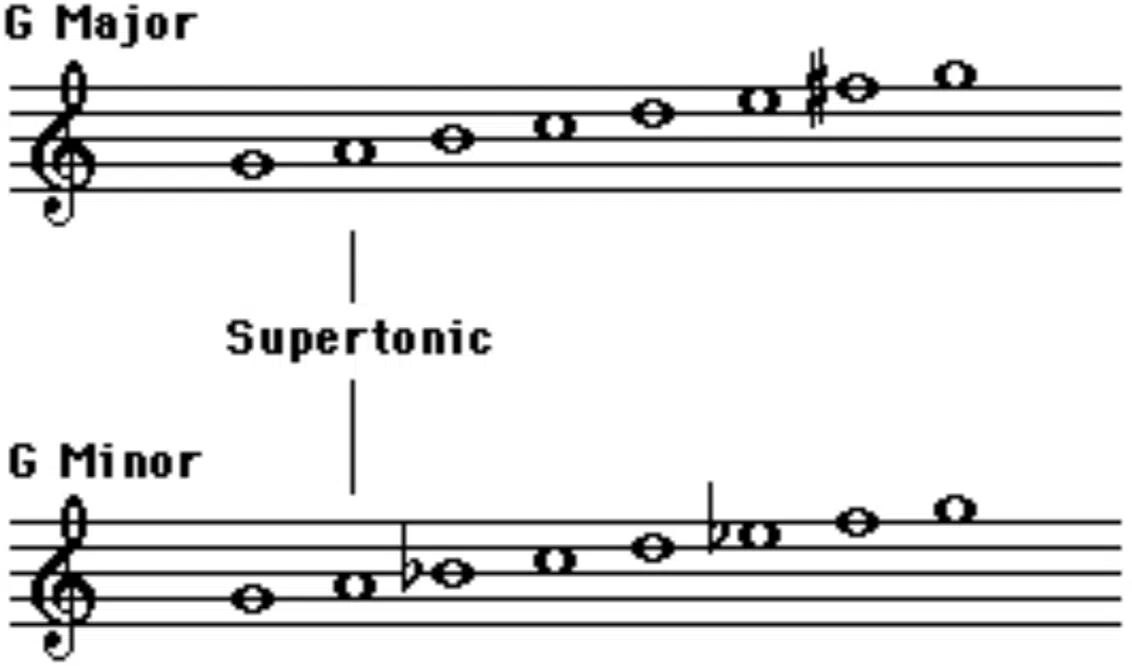
The supertonic chord functions differently depending on whether you’re working in a major or minor key… In a major scale, this chord is typically a minor chord built on the second degree.
For example, in the key of C major, the supertonic chord would be D minor (ii), consisting of the notes D, F, and A.
This minor chord adds contrast and prepares the ear for a more dominant or subdominant resolution.
In a minor key it often appears as a diminished chord, like D diminished (iiº) in the key of A minor (consisting of D, F, and A♭).
This diminished chord creates more tension and drama in the progression 一 leading flawlessly into either the dominant or tonic chords.
For example, in a iiº-V-i progression in A minor, the dissonant nature prepares for a highly impactful resolution when it reaches the tonic.
NOTE: You can intensify this effect by using first inversion of the supertonic or incorporating the leading tone to heighten anticipation before resolving.
But remember, it all depends on the context of your unique composition.
The Supertonic’s Role in Melodies and Harmonies

The supertonic note also plays an important role in melodies because it provides a transition between the tonic and other notes in the scale, leading into the:
- Mediant
- Dominant
- Subdominant
For example, in a melody in the key of G major, the A (supertonic note) can lead into the B (called the mediant) or resolve into the dominant D.
You can experiment in your DAW with sequencing the supertonic in MIDI.
It’ll help you create interesting variations by shifting the supertonic note into different octaves or adjusting its length to fit your melodic phrasing.
Harmonically speaking, the supertonic triad interval helps create movement and interest (as it usually leads into more stable chords like the tonic or dominant).
For example, you might use a supertonic chord to create tension in a verse, which prepares for a dominant resolution in the chorus.
This interval creates a super fresh sound in your melodies and harmonies 一 giving your music more depth and tension.
NOTE: Automating dynamics or modulation to emphasize the supertonic can add even more emotional weight and excitement to the transitions in your track.
Bonus Must-Knows for Producers
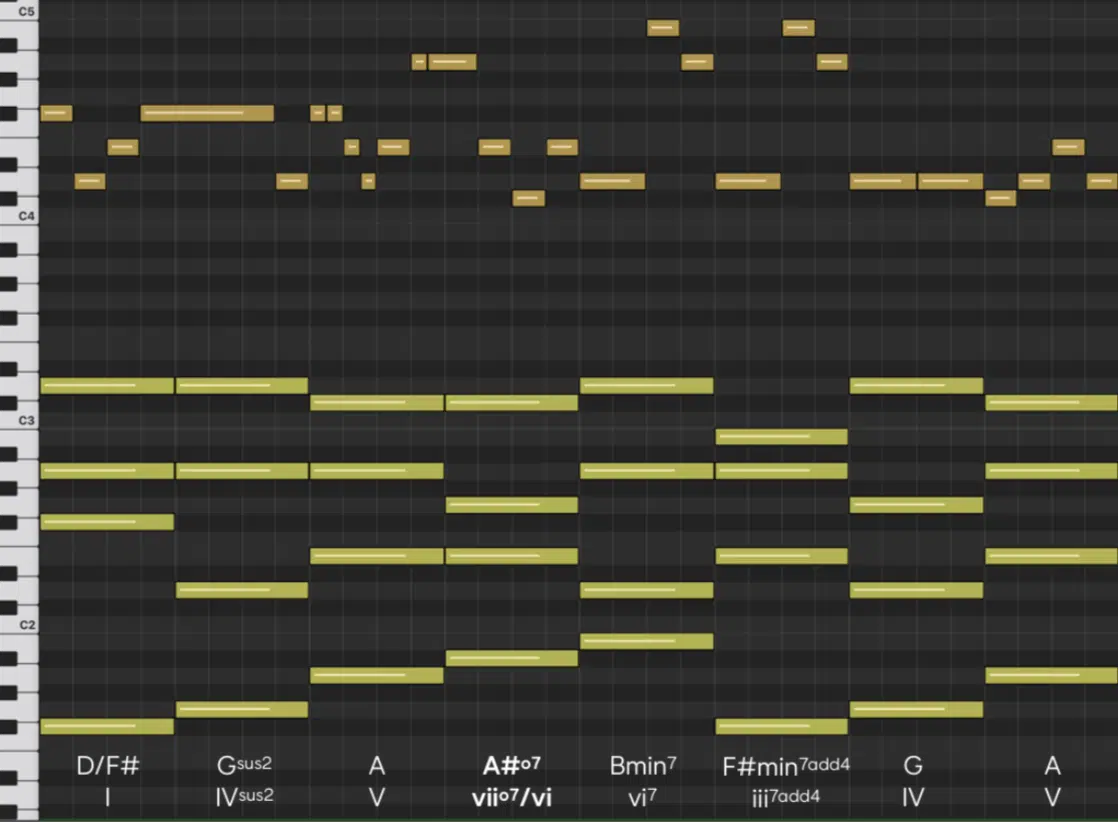
diminished chords
As a music producer, understanding how to use the supertonic like a boss can elevate your compositions as a whole.
For example, you can use the supertonic triad to transition smoothly between different sections of your track, such as from a verse to a chorus, by creating tension.
Tension that, as you now know, resolves into the tonic or dominant.
In genres like pop or EDM, you can place the supertonic chord in first inversion, which helps soften the transition while maintaining fresh harmonic movement.
If you’re working with minor keys, using it as a diminished chord can add drama and create a stronger pull towards your dominant chord.
This will make your drops or transitions way more impactful.
You can also practice modulating to the supertonic when transitioning between different sections to give your music a fresh sound while maintaining harmonic cohesion.
Bottom line, whether you’re building chord progressions, harmonies, or even melodic lines, it’s a great tool to give your track a dynamic edge.
Final Thoughts
The supertonic, as you now know, is the second degree of the scale, and it plays a key role in both major and minor key progressions.
It can help you create killer transitions between chords, build harmonic tension, and guide your melodies toward an epic resolution.
Plus, understanding how to incorporate the supertonic triad, use first inversion, and resolve to the dominant or tonic will make your tracks sound more professional.
By using all the information we’ve given you in today’s article, you’ll be able to use it in your tracks all day (and master it in no time).
As an added bonus, you’ve got to check out these invaluable Free Emotional MIDI Chord Progressions that can take your chord progressions to the next level.
This pack includes 24 unique, royalty-free MIDI chord progressions that are designed to evoke deep emotions in your music, instantly captivating your listeners.
Whether you’re looking to add supertonic chords to a minor scale progression or simply want to enhance the emotional depth of your music, they’ve got you covered.
You can easily drag and drop them into your DAW so you can focus on building out your sound without worrying about complex theory.
So, make sure to go practice, keep experimenting, and your progressions will never sound the same again.
Until next time…







Leave a Reply
You must belogged in to post a comment.